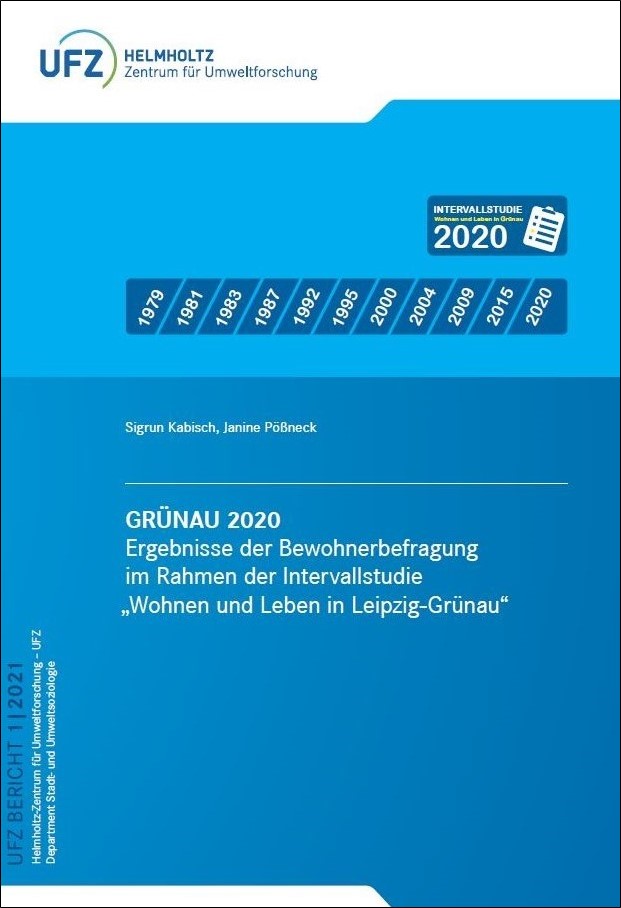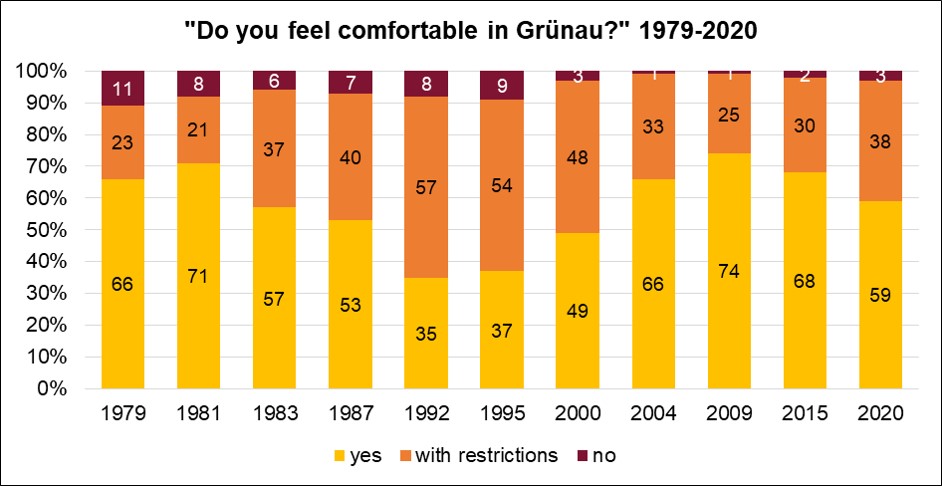
GRÜNAU 2025
12th resident survey as part of the long-term study
"Housing and Living in Leipzig-Grünau"
Leadership
Staff
Duration
until 2025

Selected Results of the 11th Resident Survey

11th Survey of the Interval Study
"Housing and Living in Leipzig-Grünau"
The development of the large housing estate Leipzig-Grünau has been accompanied sociologically since 1979 as part of the interval study “Housing and Living in Leipzig-Grünau”. At the center of this long-term study is the residents’ perspective on their living conditions and the social environment. Between 1979 and 2015, ten resident surveys were conducted. The 11th survey took place in early summer 2020, after the first wave of the Covid-19-pandemic.
 The central topics of the interval study relate to residential satisfaction, mobility and place attachment, infrastructure facilities, the image of the district as well as the socio-demographic characteristic of the residents. In each survey, current issues were additionally considered. In the recent investigation of 2020, this concerns the following topics: the differentiation within Grünau based on small-scale analyses, challenges of the integration of migrants and refugees, the diversity of the ownership structure and its effects on the residential locations, the adaptation to the climate change, dealing with extreme events and the consequences of the Covid-19-pandemic.
The central topics of the interval study relate to residential satisfaction, mobility and place attachment, infrastructure facilities, the image of the district as well as the socio-demographic characteristic of the residents. In each survey, current issues were additionally considered. In the recent investigation of 2020, this concerns the following topics: the differentiation within Grünau based on small-scale analyses, challenges of the integration of migrants and refugees, the diversity of the ownership structure and its effects on the residential locations, the adaptation to the climate change, dealing with extreme events and the consequences of the Covid-19-pandemic.
The core of the study is a representative questionnaire survey. Therefore, the questionnaires are distributed to the same addresses in each survey (“Address-Panel”). Based on a tested methodological design, a very high return rate is always achieved (2020: 73%).
The resident survey was supplemented by expert interviews (e.g. with representatives of housing companies), a photo documentation, the evaluation of statistical material as well as field observations and an extensive map series. Furthermore, the perceptions and assessments of migrants and refugees, who came to Grünau since 2015/2016, were given special consideration. In order to highlight their view on their living environment, several group discussions and individual interviews were conducted.
Based on this mix of methods, results are presented that support a factual argumentation regarding the future prospects of the large housing estate Leipzig-Grünau. Of particular value are the results that are comparable over a long period of time and provide information about the dynamics, stabilities and required actions. In addition, the analyses related to different spatial scales (district, housing complex, smaller units) enable small-scale and targeted statements and recommendations.
The scientific results are available to Leipzig's urban policy, city administration and planning institutions, the interested housing companies and local initiatives. In the district magazine “Grün-As”, articles on the implementation of the survey and on selected results can be read repeatedly. At public events, the results are discussed with the Grünau residents.
Here you find the research report:
Publications
Kabisch, S., Pößneck, J. (2024): Wohnen mittels Langzeitstudien erforschen. Zur Perspektive der Bewohner:innen auf die Dynamik des Wohnens. In: Meuth, M., von Mende, J., Krahl, A. J., Althaus, E. (eds.): Wohnen erforschen. Qualitative Methoden und forschungspraktische Reflexionen. transcript Verlag, Bielefeld, 229-241. Full text (URL)
Kabisch, S., Pößneck, J. (2024): Wenn die Existenz auf dem Spiel steht – Zum Umgang mit Krisen auf Quartiersebene am Beispiel von Großwohnsiedlungen. In: Kabisch, S., Rink, D., Banzhaf, E. (eds.): Die Resiliente Stadt: Konzepte, Konflikte, Lösungen. Springer Spektrum, Berlin, Heidelberg, 127-141. Full text (DOI)
Kabisch, S., Pößneck, J. (2022): Sitzgelegenheiten im wohnungsnahen Freiraum. Erholung zwischen Wunsch und Realität in Leipzig-Grünau. Stadt+Grün 09/2022, 51-57. Online (URL)
Kabisch, S., Pössneck, J. (2022): Various images versus the stigma of large housing estates: The Leipzig-Grünau example. disP - The Planning Review 58(1), 36-48. Full text (DOI)
Kabisch, S., Pößneck, J. (2022): Bänke im Wohnumfeld – Defizite und Konsequenzen. Eine Bestandsaufnahme im Rahmen der Intervallstudie Grünau (siehe auch Quartalsbericht II/2021 und IV/2021). In: Stadt Leipzig, Amt für Statistik und Wahlen. Statistischer Quartalsbericht I/2022, 58-74.
Download (PDF, German)
Kabisch, S., Pößneck, J. (2022): Unsicherheit im Umgang mit dem Klimawandel im Wohnumfeld. Ergebnisse der Erhebung 2020 in der Großwohnsiedlung Leipzig-Grünau. In: Stadt Leipzig, Amt für Statistik und Wahlen. Statistischer Quartalsbericht IV/2021, 45-50.
Download (PDF, German)
Kabisch, S., Pößneck, J. (2021): Das soziale Miteinander auf der Nachbarschaftsebene als zentraler Faktor für das Wohlfühlen in Grünau. Ergebnisse der Erhebung 2020 in der Großwohnsiedlung Leipzig-Grünau. In: Stadt Leipzig, Amt für Statistik und Wahlen. Statistischer Quartalsbericht II/2021, 31-44. Download (PDF, German)
Kabisch, S. (2021): Facetten der Partizipation in der Großwohnsiedlung Leipzig-Grünau aus Bewohner*innenperspektive. In: Harnack, M., Brunner, M., Heger, N. (eds.): Transformative Partizipation: Strategien für den Siedlungsbau der Nachkriegsmoderne. Berlin: JOVIS, 69-82. Online (URL)
Kabisch, S., Pößneck, J. (2021): Intervallstudie "Wohnen und Leben in Leipzig-Grünau". Rundbrief Geographie, Forschungsforum, 12-13.
Kabisch, S., Pößneck, J. (2021): Grünau 2020. Ergebnisse der Bewohnerbefragung im Rahmen der Intervallstudie „Wohnen und Leben in Leipzig-Grünau“. UFZ-Bericht 1/2021, Leipzig. https://doi.org/10.57699/76TC-4757. Download (PDF, German, research report Grünau 2020)
Kabisch, S. (2021): Wohnen in der Großwohnsiedlung. In: Eckardt, F., Meier, S. (eds.): Handbuch Wohnsoziologie: Prozesse, Räume und Kontexte des Wohnens. Wiesbaden: Springer Fachmedien. Online (DOI)
Kabisch, S., Poessneck, J., Soeding, M., Schlink, U. (2021): Measuring residential satisfaction over time: results from a unique long-term study of a large housing estate. Housing Studies 37(10), 1858-1876. Full text (DOI)
Kabisch, S. (2020): Großwohnsiedlung als sozialistisches Wohnmodell und dessen Karriere: Das Beispiel Leipzig-Grünau. In: Breckner, I., Göschel, A., Matthiesen, U. (eds.): Stadtsoziologie und Stadtentwicklung: Handbuch für Wissenschaft und Praxis. Baden-Baden: Nomos, 283-294. Online (DOI)
Kabisch, S. (2020): Großwohnsiedlungen - Herausforderungen und Zukunftschancen im deutsch-tschechisch-polnischen Vergleich. In: Wékel, J. (eds.): Stadt denken 4. Berlin: Deutsche Akademie für Städtebau und Landesplanung (DASL), 107-118. Online (URL)
Kabisch, S. (2019): Leipzig‐Grünau: Dynamiken und Persistenzen einer Großwohnsiedlung. In: Pasternack, P. (ed.): Das andere Bauhaus-Erbe. Leben in den Plattenbausiedlungen heute, Berlin: BWV – Berliner Wissenschafts-Verlag, 85-98.
Kabisch, S. (2019): Leipzig-Grünau. In: John, U., von Hehl, U. (eds.), Geschichte der Stadt Leipzig; Band 4: Vom Ersten Weltkrieg bis zur Gegenwart. Leipzig: Leipziger Universitätsverlag, 852-856.
Kabisch, S., Ueberham, M., Söding, M. (2018): Dynamiken der Großwohnsiedlung Leipzig-Grünau aus Bewohnersicht in der Langzeitperspektive. In: Altrock, U., Grunze, N., Kabisch, S. (eds.): Großwohnsiedlungen im Haltbarkeitscheck: differenzierte Perspektiven ostdeutscher Großwohnsiedlungen. Wiesbaden: Springer VS, 119-143. Online (DOI)
Kabisch, S., Ueberham, M., Schlink, U., Hertel, D., Mohamdeen, A.M.S. (2018): Local residential quality from an interdisciplinary perspective: combining individual perception and micrometeorological factors. In: Kabisch, S., Koch, F., Gawel, E., Haase, A., Knapp, S., Krellenberg, K., Nivala, J., Zehnsdorf, A. (eds.): Urban transformations − Sustainable urban development through resource efficiency, quality of life and resilience, Future City 10. Cham: Springer International Publishing, 235-255. Online (DOI)
Kabisch, S., Ueberham, M., Söding, M. (2016): Grünau 2015. Ergebnisse der Einwohnerbefragung im Rahmen der Intervallstudie „Wohnen und Leben in Grünau“. UFZ-Bericht 02/2016, Leipzig. Download (PDF, German, research report Grünau 2015)
Kabisch, S., Ueberham, M., Söding, M. (2016): 40 Jahre Stadtteil Grünau – 36 Jahre „Intervallstudie Grünau“ (Teil 1). In: Stadt Leipzig, Amt für Statistik und Wahlen. Statistischer Quartalsbericht I/2016: 33-36.
Download (PDF, German)
Kabisch, S., Ueberham, M., Söding, M. (2016): 40 Jahre Stadtteil Grünau – 36 Jahre „Intervallstudie Grünau“ (Teil 2). In: Stadt Leipzig, Amt für Statistik und Wahlen. Statistischer Quartalsbericht II/2016: 29-32. Download (PDF, German)
Großmann, K., Kabisch, N., Kabisch, S. (2016): Understanding the social development of a post-socialist large housing estate: The case of Leipzig-Grünau in eastern Germany in long-term perspective.
Eur. Urban Reg. Stud.
Full text (PDF)
Kabisch, S., Rink, D. (2015): Governing Shrinkage of Large Housing Estates at the Fringe. In: Hamel, P., Keil, R. (eds.), Suburban Governance: A Global View, Toronto, Buffalo, London: University of Toronto Press, 198-215.
Kabisch, S., Großmann, K. (2013): Challenges for large housing estates in light of population decline and ageing: Results of a long-term survey in East Germany. In: Habitat International 39 (2013) 232-239. Full text (PDF)
Political statements (in German)
Research reports of the past surveys (in German)
Videos
"Die Platte im Aufwind"
Article on Grünau from Carolyn Wissing (Einundleipzig), incl. video-interview with Prof. Dr. Sigrun Kabisch.
Interview − Prof. Dr. Sigrun Kabisch talks about the development and today's setting of Grünau:
